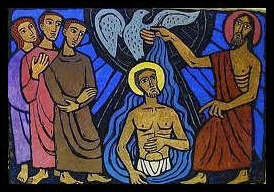Vatican II requested a rewriting of the baptism ritual but the baptismal promises are about the same today as they were during the  first centuries. The three basic baptismal promises are accepted today without reservation while they could lead to persecution during the first centuries: belief in one universal God -- and no divine Emperor -- (accepted by about 90% of Americans), belief in Jesus Christ the only Son of God (accepted by 70% of Americans), and the rejection of Satan and all idol worship (about 50% of Americans do not even believe in the devil, let alone worshipping idols). In short, the baptismal promises are vague and not demanding.
first centuries. The three basic baptismal promises are accepted today without reservation while they could lead to persecution during the first centuries: belief in one universal God -- and no divine Emperor -- (accepted by about 90% of Americans), belief in Jesus Christ the only Son of God (accepted by 70% of Americans), and the rejection of Satan and all idol worship (about 50% of Americans do not even believe in the devil, let alone worshipping idols). In short, the baptismal promises are vague and not demanding.
The Tridentine spirituality of frequent confession and communion is not mentioned in Vatican II. Today, communion is a near automatic part of Mass attendance, and individual confession is practiced less and less.
 RCIA can be taken as a model of baptism initiation because it consists of several months of baptismal mystagogy. After months of "immersion" (baptism in Greek) in the Holy Spirit, the baptismal promises are meaningful for life.
RCIA can be taken as a model of baptism initiation because it consists of several months of baptismal mystagogy. After months of "immersion" (baptism in Greek) in the Holy Spirit, the baptismal promises are meaningful for life.
Infant baptism can be as effective as RCIA if the years of preparation for confirmation and first communion are an "immersion" in the Holy Spirit. What is needed is baptism mystagogy rather than catechism. I take mystagogy in the broad sense of pedagogy into the sacred, or initiation experience into the Christ mystery ; these forms of sacredness should be central to all liturgies, homilies, and teachings; it is much more than catechism, doctrinal instruction, or ritual performance. Unfortunately there is often little mystagogy in church practices.
Here are two outstanding examples of baptismal mystagogy. In a special parish, "St. Mary, Star of Hope," confirmation preparation covers four to six years in small peer groups under the dual leadership of an adult and a senior student. Students meet weekly for two hours during the week and celebrate
 the Eucharist together at a teen Mass on Sunday afternoon. After confirmation, about half of the confirmed continue as peer ministers. For them the baptismal commitment has an existential meaning, that of a community of friends and mystagogy.
the Eucharist together at a teen Mass on Sunday afternoon. After confirmation, about half of the confirmed continue as peer ministers. For them the baptismal commitment has an existential meaning, that of a community of friends and mystagogy.
In dynamic Latin American parishes, adult retreats are a new form of mystagogy. In short, every year there is a drive to attract new members who will receive catechesis for about two or three months, followed by a weekend retreat. From the beginning, they form small communities of faith that will meet weekly - for life - for a couple of hours. This model is commonly found, from Mexico to Brazil, in dynamic parishes. When mystagogy is experienced within a community of friends, the baptismal promises become part of one's identity, hence become an indelebile character of one's personality, but without baptismal mystagogy, the baptismal promises have little meaning.
These two examples make it clear that the purpose of baptismal initiation is rebirth, a new creation, awakening from death, sleep and slumber, into a new life in the spirit.
In summary, baptismal spirituality and baptismal mystagogy are the way of the future; they can revitalize traditional devotions and expand the Catholic imagination.
From Joe Martos:During the first centuries of Christianity, people were expected to live the teachings of Jesus before being fully initiated into the community through baptism. Beginning in the fourth century, when the numbers wanting to join the church grew very large, people were catechized for a few months, baptized and confirmed, and given more intensive teaching about the Christian mysteries afterwards. Mystagogy, then, was part of an attempt to do after baptism what previously had been done before baptism.Today confirmation is a rite of passage like the rite of marriage; it celebrates a passage from one state in life to another like a graduation ceremony. The problem is that none of the reigning theologies of confirmation takes this into account. Confirming children just before they make their first holy communion does not celebrate any real transition in their lives. Children who get anointed with chrism before receiving communion are no different from children who don’t—except in the minds of the people who believe this theory.Confirming adolescents suffers from the same weakness. Teenagers are told that they are making an adult faith commitment and that they are becoming fully initiated members of the church, but most of them stop coming to church soon after they are confirmed. For some youngsters, preparation for the sacrament may lead to a rethinking of their faith and a deeper commitment to their baptism, but what happens for some cannot be elevated into a universal truth for all. |